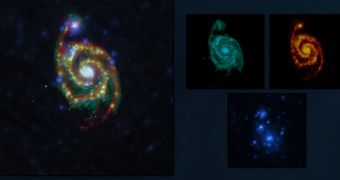Astronomers operating the European Space Agency's (ESA) XMM-Newton telescope and the Herschel Space Observatory recently conducted an in-depth investigation of the stellar populations in the Whirlpool Galaxy (also known as M51 and NGC 5194). Their work has revealed the presence of three distinct star age groups in the nearby cosmic structure.
Whirlpool is a majestic, two-arm spiral galaxy that lies just 30 million light-years away from Earth. This makes it easily visible as a blob to binoculars and small telescopes. However, when using observatories the size of Herschel, the object reveals all of its innards in their majestic splendor.
The two telescopes were able to discover three distinct stellar populations within the galaxy. Herschel imaged Whirlpool in red and yellow – two distinct infrared wavelengths – while ultraviolet data from XMM-Newton appear in green in this composite view of the galaxy.
Herschel reveals the massive amounts of dust and gas that will lead to the formation of new stars in the nearby future, as well as the vast array of stars that are currently in their main sequence. XMM data shows the youngest and most violent stars in the Whirlpool, which make nearby dust glow by bombarding it with ultraviolet radiations.

 14 DAY TRIAL //
14 DAY TRIAL //